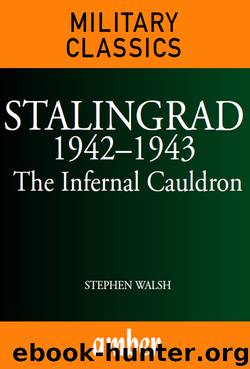Stalingrad 1942 - 1943 by Stephen Walsh

Author:Stephen Walsh
Language: eng
Format: azw3, mobi, epub
Publisher: Amber Books Ltd
Published: 2010-06-27T23:00:00+00:00
CHAPTER 6
The Encirclement of 6th Army
Operation ‘Uranus’ 19–23 November 1942
General Paulus and German high command were aware of the vulnerability of 6th Army to a Soviet counteroffensive, particularly one from the north designed to trap it against the Volga.
As early as 12 September 1942, in conference with Hitler at Vinnitsa, in the eastern Ukraine, Paulus had expressed concern about 6th Army’s exposed left flank. To the north-west of Stalingrad and directly to the south of the city, 6th Army’s outer flanks were monitored by ill-equipped Romanian and Italian formations. Although the potential dangers of this situation were understood by the 6th Army and German high command, they could not be remedied unless Army Group A was withdrawn from the Caucasus. Once again, German military planning crossed swords with the plain fact that the German Army simply did not have enough men to cover the entire front.
At the tip of an enormous salient, bereft of reserves, 6th Army was trapped in an unparalleled battle of attrition. It was dependent upon a single rail line which crossed the Don at Kalach, a mere 96.5km (60 miles) from the Soviet front line. All 20 divisions of 6th Army and 4th Panzer were engaged in and around Stalingrad at the eastern extremity of the Don–Volga salient. The three panzer divisions of 6th Army – 14th, 16th and 24th – which were expected to protect 6th Army’s flanks, were in no fit state to do so. Serious losses and the critical fuel situation rendered their apparent strength illusory. To the south, Hoth’s 4th Panzer was a shadow of its former self. By November 1942, it did not contain a single panzer division. The 14th and 24th Panzer divisions had been given to 6th Army, while Lieutenant-General Heim’s 48th Panzer Corps now acted as Army Group B’s operational reserve within the Don bend. Yet the insurance offered to 6th Army was negligible. A full-strength panzer corps of approximately 60,000 was formidable, but Heim’s formation consisted of 1st Romanian Armoured Division, equipped with Czech tanks of 1930s vintage, and 22nd Panzer Division, which had a reputation as the unluckiest and least effective panzer division on the Eastern Front. West of Stalingrad, 48th Panzer Corps was deployed as a ‘backstop’ to 3rd Romanian Army, but Field Marshal von Weichs, Army Group B commander, needed Hitler’s express permission for its use. Hitler also promised 6th Panzer Division and two infantry divisions, but, as these units were in France, December was the earliest that Army Group B could expect them to arrive.
General Dumitrescu’s 3rd Romanian Army was deployed on the Don north-west of Stalingrad. On 24 August 1942, Soviet counterattacks had acquired the Serafimovich bridgehead and a smaller one to the east at Kletskaya, both on the southern bank of the Don. The Romanians held a 160-km (100-mile) sector with eight infantry and two cavalry divisions, with the prospect of support from 48th Panzer Corps. In November 1942, 3rd Romanian’s strength was 170,000, but each division covered 20km (12.4 miles) of the front, virtually twice the standard.
Download
Stalingrad 1942 - 1943 by Stephen Walsh.mobi
Stalingrad 1942 - 1943 by Stephen Walsh.epub
This site does not store any files on its server. We only index and link to content provided by other sites. Please contact the content providers to delete copyright contents if any and email us, we'll remove relevant links or contents immediately.
Smithsonian Civil War by Smithsonian Institution(970)
Tiger I and Tiger II (Images of War) by Anthony Tucker-Jones(948)
Battle Cry of Freedom by James M. McPherson(898)
Deadliest Men by Kirchner Paul(775)
The Pacific War by Robert O'Neill(769)
Maps of War by Jeremy Black(747)
Flags of Our Fathers by James Bradley & Ron Powers(740)
D-Day, June 6, 1944: The Climactic Battle of World War II by Stephen E. Ambrose(698)
Third Reich Propaganda (The Third Reich From Original Sources) by Carruthers Bob(692)
Lewes and Evesham 1264-65 by Richard Brooks(662)
The Oxford Illustrated History of the First World War by Hew Strachan(632)
The French Army in the First World War by Ian Sumner(626)
Frames of War by Judith Butler(571)
Early Samurai AD 200-1500 by Anthony J Bryant(559)
American Amphibious Gunboats in World War II by Robin L. Rielly(537)
Battle Cry of Freedom: The Civil War Era (Oxford History of the United States) by McPherson James M(536)
Kursk 1943 by Robert Forczyk(513)
The Nazis – A Warning from History by Laurence Rees(511)
The Civil War by Geoffrey C. Ward(510)
